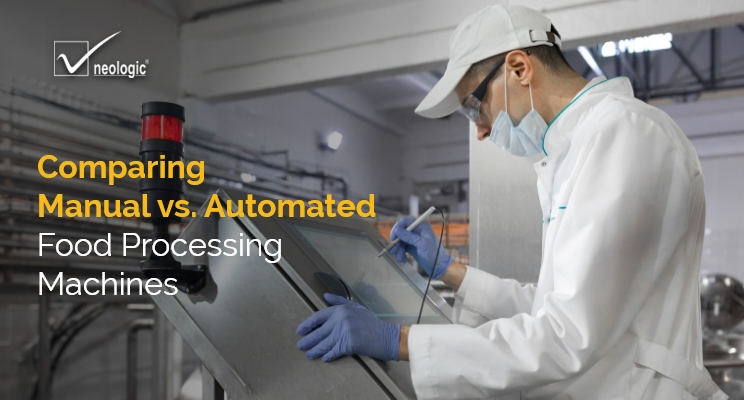
Comparing Manual vs. Automated Food Processing Machines
The food processing industry has undergone significant transformation in recent years, driven by advancements in technology and the growing demand for efficiency, consistency, and scalability. Two primary approaches dominate the landscape: manual and automated food processing equipment.
Each method offers distinct advantages and challenges, making the choice between them dependent on factors such as production scale, cost, product quality, and operational goals. This blog provides a detailed comparison of manual and automated food processing equipment to help you choose what’s best suited for you.
Overview of Manual & Automated Food Processing Equipment
Manual food processing equipment relies on human labor to perform tasks such as cutting, mixing, packaging, or sorting. Examples include hand-operated slicers, grinders, and small-scale packaging tools. These systems are typically simple, requiring minimal technical expertise to operate, and are often found in small businesses, artisanal producers, or operations with low production volumes.
Whereas automated food processing equipment leverages robotics, sensors, and programmable logic controllers (PLCs) to execute tasks with minimal human intervention. Examples include conveyor-based cutting systems, automated filling machines, and smart packaging lines. These systems are designed for high-throughput environments like large-scale manufacturing plants and are increasingly integrated with artificial intelligence (AI) and Internet of Things (IoT) technologies for real-time monitoring and optimization.
Key Comparison Factors
1. Efficiency and Speed
- Manual: Manual equipment is inherently slower due to its reliance on human operators. Processing speed varies with worker skill and fatigue levels, limiting output to dozens or hundreds of units per hour depending on the task. For instance, a skilled worker using a manual slicer might process 50 kilograms of vegetables in an hour, but consistency and pace decline over time.
- Automated: Automated systems excel in speed and efficiency. Modern machines, such as those produced by food processing equipment manufacturers like Neologic Engineers, can process thousands of units per hour.
2. Cost Considerations
- Manual: Initial costs for manual equipment are low, often ranging from a few hundred to a few thousand dollars. However, long-term operational costs can escalate due to labor expenses. With rising minimum wages in many regions, labor-intensive processes are becoming less economical.
- Automated: Automated equipment requires a significant upfront investment, often in the tens or hundreds of thousands of dollars. However, these systems reduce labor costs over time and offer a strong return on investment (ROI) for high-volume producers, typically within 2-5 years.
3. Product Quality and Consistency
- Manual: Human-operated systems allow for greater control over delicate or artisanal products, such as hand-crafted cheeses or specialty baked goods. However, variability between workers can lead to inconsistent output, impacting brand reliability.
- Automated: Automation ensures uniformity, critical for mass-market products like frozen meals or canned goods. Advanced sensors and AI-driven quality control, as seen in systems, detect defects in real time, reducing waste and ensuring compliance with stringent food safety standards like HACCP.
4. Scalability
- Manual: Scaling manual operations requires hiring and training additional staff, which introduces logistical challenges and increases costs exponentially. Small businesses often hit a ceiling where demand outstrips feasible manual output.
- Automated: Automated systems are built for scalability. Adding capacity often involves software updates or modular equipment expansions rather than a proportional increase in labor.
5. Flexibility
- Manual: Manual equipment offers high flexibility, allowing operators to switch tasks or adapt to new recipes quickly without reprogramming. This is a key advantage for producers of seasonal or custom products. Handling different recipes requires special experience, skills and creates dependencies on specific peoples.
- Automated: While automation excels in repetitive tasks, it can be less adaptable. Although, it could be less adaptable but it can, in most cases, be used for processing different product. Handling different recipes from SCADA/HMI is just a click away and can be performed by routine staff hence does not require special skillset or dependencies on operators.
6. Environmental Impact
- Manual: Manual systems typically consume less energy upfront but may contribute to waste through human error. For example, inconsistent cutting can increase food scraps. Utility consumption can be higher as there is continuous requirement of manual monitoring and control.
- Automated: Automated equipment often incorporates energy-efficient designs and waste-reduction features. An analysis by the International Food Information Council found that automated systems reduced material waste by up to 30% compared to manual counterparts, though they require more electricity, prompting a shift toward renewable energy integration in modern plants. However automated system can provide better control over utility consumption by PLC programs and also daily consumption can be recorded with the help of field instruments. This consumption data can be used for further analysis.
Industry Trends in 2025
The food processing sector is increasingly favoring automation, driven by labor shortages and consumer demand for affordable, safe products. Large food manufacturers plan to increase automation investments over the next decade. However, manual equipment retains a niche in small-scale, high-value markets like organic or artisanal goods, where craftsmanship is a selling point.
In Conclusion, choosing between manual and automated food processing equipment hinges on specific business needs. Manual systems suit small operations prioritizing flexibility and low initial costs, despite their limitations in speed and scalability. Automated systems, while expensive upfront, dominate in efficiency, consistency, and long-term savings, making them the backbone of industrial food production.
Webinar: IoT Ready
Food Processing Industry
Understand why manufacturers are transforming their processing lines from manual to
automated with our Emerging Food Tech Webinar series.